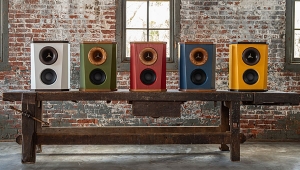| Columns Retired Columns & Blogs |
David Wilson: WAMM!! WATT?!? WHOW!!! (& the Puppies!)
The French have a phrase for it: plus ça change, plus la même chose, which can be roughly translated as "the more things change, the more they stay the same." I was reminded of this when recently reading through the December 1980 issue of The Absolute Sound. There on p.368 was the statement that "Dave Wilson (Virgo) has joined the staff...to construct a testing program that will allow us to determine if some of the peculiarities and anomalies we hear in evaluating equipment can indeed be numerically measured."
Ten years later, both TAS and Stereophile are still expending a goodly portion of their creative energy budgets toward that apparently chimeric goal. In the meantime, David Wilson, who ten years ago, that 1980 editorial entry noted, was "attempting to design a professional recording monitor system...of astronomic cost..." has become one of the major figures both in high-end loudspeaker design and in musically honest recording, as well as serving time as an influential member of the TAS reviewing staff. (I still remember with awe his herculean cartridge survey in TAS #26.)
That "recording monitor system" metamorphosed into the $88,000 Wilson Audio Modular Monitor system—the WAMM—which, shown for the first time at the 1982 Winter Consumer Electronics Show (WCES), is now in its sixth incarnation, while the last few years have seen Wilson Audio, which David runs with his singer wife Sheryl-Lee, introducing the WATT and WATT II minimonitors, the POW-WHOW powered subwoofer, and most recently, the Puppies, a stereo woofer system to extend the low-frequency reach and dynamic range of a pair of WATT IIs.
David visited New Mexico earlier this year to fix a WAMM system that the owner had inadvertently damaged with what David described as some "overexuberant, rambunctious Linda Ronstadt mariachi yelps!" He took some time out to visit Stereophile publisher Larry Archibald and me in Santa Fe; our conversation started with my asking him how many WAMM systems had been sold since 1982?
David A. Wilson: There are now 25 WAMM systems in various parts of the world.
John Atkinson: One, of course, being in New Mexico.
Wilson: The midrange drivers had gone on one channel, so it was a simple matter to replace them. And I get to know the people that own WAMM systems personally because I've calibrated all of those systems. I like to visit them just socially from time and time. It had been about a year since I'd seen this gentleman, so this gave me an opportunity to see him and to set his system right.
Atkinson: How does the Series 6 WAMM differ from the earlier versions?
Wilson: WAMM needs to be considered as an architecture rather than as a speaker per se. Some elements of the system haven't changed at all in almost 10 years, and others have. The system in terms of loudspeaker towers consists of four 6½' towers. Two of them are subwoofers which operate below 55Hz and the other two are what we call full-range arrays. These have a midbass module which, if you run it without low-frequency rolloff, has response to 27Hz; but we roll off the response to that full-range array at about 40Hz. There is some intentional overlap between the responses of the subwoofer and the midbass module.
Above the midbass module, quite literally, is a tower, a machined unit consisting of two midrange modules which flank an electrostatic high-frequency module. Each of these modules are adjustable back and forth to achieve time-domain alignment relative to each other. That architecture has not changed. The system also includes an electronic crossover and an equalizer which starts life as a Crown EQ2; we do extensive modifications to that unit. Over the years the modifications have increased to the point where I'm beginning to think that we ought to just build our own. John Curl and I have talked about that quite a bit, and he has a basic design which, if we build it, will allow balanced throughputs for applications that require that.
Atkinson: What range does the electrostatic unit cover?
Wilson: It operates above 5kHz. And it operates at a very low level. It functions primarily to provide part of the leading edge of high-frequency transients.
The original Series 1 and Series 2 WAMMs had as midrange modules compact speakers that were sourced from Braun. These had metal enclosures, a 4" woofer, and a 1" dome tweeter. The crossover network within those midrange modules was of good but not great quality; the tweeter, very smooth, very predictable. The little woofer had very good rise time and transient response. By the Series 3, which occurred in mid-'83, I had gone over completely to the M3 midrange module which we built ourselves, whose enclosure material was a sandwich, if you will, of acrylic materials. We started using the SEAS 11FM midrange driver in place of the Braun unit, which was quite an improvement. We went to a better crossover unit but we retained the Braun tweeter.
By Series 5—which was an experimental prototype only—I was looking at ways of making the midrange module more like the WATT, so that it had better time-domain behavior. The enclosure would be essentially maximally inert; the crossover unit also would be electromagnetically shielded. The elements within it would be electrostatically aligned, and the whole structure would be potted for maximal vibration-damping qualities...
However, I had reached a decision point with the Series 5 as to whether to continue the WAMM as a product or to discontinue it. We were terribly busy with the WATT, and you can't bank on WAMM sales. But I finally decided, let's go for it—full speed ahead. The Series 6 is a dramatic change from the Series 4: it has the M6 midrange modules; it has an extensively re-engineered interior structure for the midbass module; the electrostatic modules have a new power supply; it has all new crossovers; it has extensive changes in the equalizer; and its level of finish has gone up substantially.
Atkinson: I assume the time alignment of the WAMM must be critical, which is presumably why the WAMM purchaser gets your help in setting up the system.
Wilson: Well, the setup of the WAMM system is an interesting procedure. Generally, before building the system I have a good idea of the room that it's going into, the associated equipment, and the listening tastes of the owner. In most instances I've had extensive discussion with the owner and I know what that person's feelings about music are. And of course the woods have been selected...the gestation period for a WAMM is anywhere from four to seven months.
When the WAMMs are delivered, I like to arrive the day before and inspect the room—they're all, incidentally, located in homes; there are none in studios or anything like that, as they're quite overbuilt for studio use. I like to make sure that the associated equipment is installed properly, and to be there to inspect the WAMMs for any damage when they arrive. After general placement of the speakers in the room, I do an acoustical analysis of the room using pink noise and impulse information, just to give me an idea, a fingerprint if you will, of the room and of how the system's interacting with the room.
Over the years, since I have installed the system in many different types of rooms in many locations, that has become fairly predictable. You can tell from drawings, the dimensions, the materials used, pretty much what it's going to sound like. Also, in most instances, the owner has had experience with other speaker systems in that room, so we pretty much know what we're facing. But the first real process that I do is the time alignment. And that's a totally objective process that could probably be done by a properly trained chimpanzee! [laughs]
The next process is general equalization using recordings that I have done. As you know from your personal experience, there are insights that you can have into the sound if you use your own recordings, that frankly no one else can have. They allow you a deeper level of analysis.
And then for me, the most exciting part of the process occurs, and I usually do this the next morning. I allow a good long night's sleep, then I do the process called "voweling," where I use a recording of Ragtime Razzmatazz. I use the left hand of the piano, which has a long harmonic series, and I adjust the octave centers and the phase angles within the octave centers in both channels. By first adjusting the 1.25kHz octave, you subjectively create a narrow window of extraordinary transparency whereas before it was somewhat vague—tonally correct, but vague. And everybody who has been with me when I've made this adjustment has clearly heard this effect. Then, as you go back and forth, first down an octave, then up an octave, then down two octaves, then up two octaves, you extend that window, you open that window of transparency and focus wider and wider and wider until finally it encompasses the entire spectrum.
- Log in or register to post comments




































